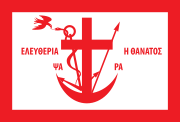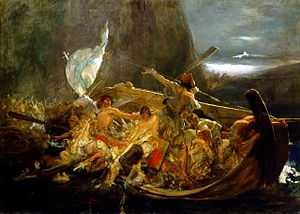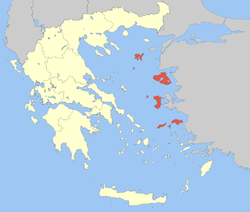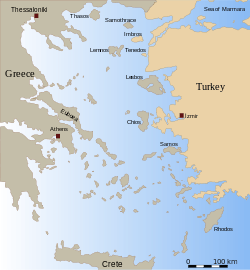Psara
| Psara Ψαρά | |
|---|---|
|
Psara, Agios Nikolaos monastery | |
 Psara | |
|
Location within the region  | |
| Coordinates: 38°33′N 25°34′E / 38.550°N 25.567°ECoordinates: 38°33′N 25°34′E / 38.550°N 25.567°E | |
| Country | Greece |
| Administrative region | North Aegean |
| Regional unit | Chios |
| Area | |
| • Municipality | 44.511 km2 (17.186 sq mi) |
| Highest elevation | 512 m (1,680 ft) |
| Lowest elevation | 0 m (0 ft) |
| Population (2011)[1] | |
| • Municipality | 458 |
| • Municipality density | 10/km2 (27/sq mi) |
| Time zone | EET (UTC+2) |
| • Summer (DST) | EEST (UTC+3) |
| Postal code | 82x xx |
| Area code(s) | 22740 |
| Vehicle registration | ΧΙ |
| Website | www.dimospsaron.gr |
Psara (Greek: Ψαρά, Psará, Greek pronunciation: [psaˈra]; formerly known as Ψύρα, Psyra, or Ψυρίη, Psyriī) is a Greek island in the Aegean Sea. Together with the small uninhabited island of Antipsara it forms the municipality of Psara. It is part of the Chios regional unit, which is part of the North Aegean region. The only town of the island and seat of the municipality is also called Psara.[2]
Psara had 448 inhabitants according to the 2011 census. It has a small port linking to the island of Chios and other parts of Greece.
Geography
Psara lies 44 nautical miles (81 km) northwest of Chios, 22 km (14 miles) from the northwestern point of the island of Chios and 150 km (93 mi) eastnortheast of Athens. The length and width are about 7 by 8 km (4 by 5 mi) and the area of the island is 43 square kilometres (17 sq mi). The highest point of the island is "Profitis Ilias" (512 metres (1,680 feet)).
Flag

The flag of Psara was designed by the Psariots[3] and bears symbols of Filiki Eteria.[4][5] It is made of white cloth bordered with red with a large red cross and the inscriptions of the name of the island "ΨΑ-ΡΑ" and the words Eleftheria i Thanatos (Liberty or Death) in capital red letters. The cross is standing on an upside down crescent, flanked on one side by a sword, on the other by a serpent killed by a bird.[3][5] The flag was carried during the War of Independence by Psariot ships[6]
An original flag of Psara, is preserved at the National Historical Museum of Greece[4]
History
It has been inhabited since the Mycenaean period, its inhabitants relying on the sea to make a living as the island is a treeless and rocky with little shrubbery. Homer first referred to the island as Psyra.[7][8]
The islanders' sole source of livelihood has always been fishing, mainly for the locally abundant slipper lobsters, and shipping, with some tourist development in recent years.
Destruction of Psara

Psara joined the Greek War of Independence on April 10, 1821. A noted native naval leader of the time was future Prime Minister of Greece Constantine Kanaris. The island was invaded on June 21, 1824 by the Ottoman navy.
On July 4 the resistance of the Psariots ended with a last stand at the town's old fort of Palaiokastro (alternative name Mavri Rachi, literally "black ridge").[3] Hundreds of soldiers and also women and children had taken refuge there when a Turkish force of 2000 stormed the fort. The refugees first threw a white flag[9] with the words "Ἐλευθερία ἤ Θάνατος" ("Eleftheria i Thanatos", "Freedom or Death"). Then, the moment the Turks entered the fort, the local Antonios Vratsanos lit a fuse to the gunpowder stock, in an explosion that killed the towners along with the their enemies — thus remaining faithful to their flag to their death.[3] A French officer who heard and saw the explosion compared it to a volcanic eruption of Vesuvius.[3]
A part of the population managed to flee the island, but those who did not were either sold into slavery or killed. As a result of the invasion, thousands of Greeks have met a tragic fate. The island was deserted and surviving islanders were scattered through what is now Southern Greece. Theophilos Kairis, a priest and scholar, took on many of the orphaned children and developed the famous school the Orphanotropheio of Theophilos Kairis.
The tragic event of the destruction of Psara inspired the poet Andreas Kalvos to write the ode "To Psara" (Greek: "Εἰς Ψαρά"); perhaps more famously, the event also inspired the poet Dionysios Solomos — the author of the Hymn to Liberty — to write in 1825 a poem (or epigram) about it called "The Destruction of Psara" (Greek: "Ἡ καταστροφὴ τῶν Ψαρῶν"):[10][11]

'Στῶν Ψαρῶν τὴν ὁλόμαυρη ράχη
Περπατῶντας ἡ Δόξα μονάχη.
Μελετᾷ τὰ λαμπρὰ παλληκάρια,
Καὶ 'ς τὴν κόμη στεφάνι φορεῖ
Γινομένο ἀπὸ λίγα χορτάρια
Ποῦ εἰχαν μείνῃ 'ς τὴν ἔρημη γῆ.
On the all-black ridge of Psara
Glory walks by herself taking in
the bright young men on the war field
the crown of her hair wound
from the last few grasses left
on the desolate earth.
Historical population
| Year | Population | Difference |
|---|---|---|
| 1824 | 7,000[12] | |
| 1951 | 700 | |
| 1961 | 576 | - 17,71% |
| 1971 | 487 | - 15,45% |
| 1981 | 460 | - 5,54% |
| 1991 | 438 | - 4,78% |
| 2001 | 422 | - 3,65% |
| 2011 | 446 | + 5,69% |
Notable people
- Constantine Kanaris (1793/1795-1877) admiral, freedom fighter and politician, Prime Minister of Greece
- Ioannis Varvakis (1745-1825), admiral, caviar merchant and benefactor.
See also
References
- ↑ "Detailed census results 2011" (in Greek).
- ↑ Kallikratis law Greece Ministry of Interior (Greek)
- ↑ 3.0 3.1 3.2 3.3 3.4 CONGRESSIONAL RECORD—HOUSE March 24, 1995
- ↑ 4.0 4.1 Flag of Psara, Revolution of 1821 -National History Museum Catalogue Number: 1752
- ↑ 5.0 5.1 Nations and States in Southeast Europe,Center for Democracy and Reconciliation in South Eastern Europe. p.99
- ↑ "Η Ελληνική Σημάια", (The Greek flag) - Hellenic Army General Staff, Page 11, Image 14:
- ↑ Homer, Odyssey, III http://classics.mit.edu/Homer/odyssey.3.iii.html
- ↑ Agelarakis A., "Report on the Main Burial of the Mycenaean Human Skeletal Remains excavated from Archontiki Site, Psara, Greece", OSSA 13 (1986-87): 3-11.
- ↑ Typos, Cyprus newspaper
- ↑ Jerome Rothenberg, Jeffrey Robinson (2009). Poems for the Millennium, Volume Three. University of California Press. p. 358. ISBN 978-0-520-25598-2.
- ↑ Solomos, Dionysios (1901). Ἄπαντα τὰ εὑρισκόμενα (in Greek). Kostis Palamas (prologue). Athens: P.D.Sakellarios. p. 99. At the Anemi digital library.
- ↑ Finlay, George. History of the Greek Revolution and the Reign of King Otho (edited by H.F. Tozer). Oxford: Clarendon Press, 1877 (Reprint: London 1971), ISBN 900834129, p. 152.
External links
- http://www.chios.com/island/psara.htm (also in German and Greek)
- http://www.sansimera.gr/archive/articles/show.php?id=156&feature=H_katastrofi_ton_Psaron (The destruction of Psara, in Greek)
- http://www.ptolemais.com/shmaies/epanastatimena.htm (The flags of the rebellious islands (Psara), in Greek)
| ||||||||||||||||||||||||||||||||||

